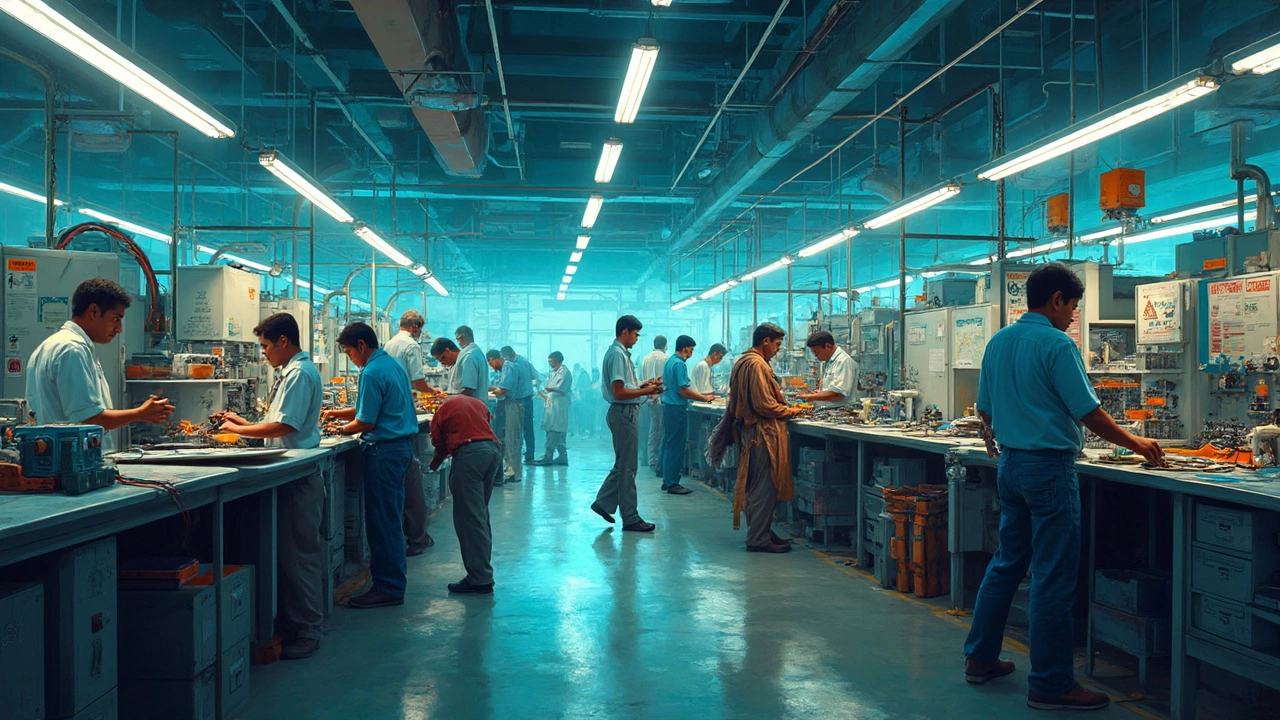 Apr, 19 2025
Apr, 19 2025
Here’s something that trips people up all the time: India doesn’t use 110V like the US or Japan. The whole country runs on 220 volts, 50 Hz. If you’re into electronics or thinking about manufacturing gear in India, this isn’t just a technical detail—it’s the first thing you need to know before you plug in anything.
Most gadgets and appliances you’d find in Indian homes or factories rely on this 220V standard. Bring a 110V-only device from abroad and plug it in without a transformer, and you’re asking for fireworks—not in a good way. This isn’t some random number India picked either; there’s a logic to why 220V makes sense here, which ties back to power delivery and efficiency across long distances.
- Why India Uses 220V, Not 110V
- Plug Types and Compatibility Issues
- What It Means for Electronics Manufacturers
- Practical Tips for Adapting Devices in India
Why India Uses 220V, Not 110V
If you’ve ever noticed your phone charger or laptop adapter, you might see small print with numbers like “100-240V,” and that’s no accident. India voltage standards are set to 220 volts, which isn’t just some random choice—it’s a big deal when it comes to power distribution. Here’s why India, and most of the world outside North America, sticks with 220V:
- Efficient power delivery: Sending power over long distances at higher voltage means less power wasted as heat. That matters when you’re running wires all over a huge country. 220V lets you get the same amount of juice with less current, saving copper in the wiring and cutting losses.
- History and standards: India adopted the British power system back in the day. Britain used 220-240V, so when India’s grid came together, switching to 220V was the easy move—no need to reinvent the wheel.
- Most devices are made for 220V markets: Since Europe, Asia, and Africa mostly use 220-240V, manufacturers build their gear to match. This keeps things simple for everyone making or selling electronics in India.
- Safety tradeoffs: Sure, 220V is more dangerous if you get shocked compared to 110V, but it allows for smaller cables and more efficient transmission, which matters more when you’re working at scale.
Take a look at the global breakdown:
| Region | Standard Voltage |
|---|---|
| India | 220V |
| Europe | 220-240V |
| USA/Canada | 110-120V |
| Japan | 100V |
So if you’re involved in electronics manufacturing for India, building your products to run at 220V is the default. It fits the grid, people expect it, and it keeps costs down from the start. Trying to do anything else just complicates things.
Plug Types and Compatibility Issues
If you’re bringing devices to India or setting up electronics manufacturing, plug types can be a real headache. India mainly uses plug types C, D, and M. Type C is that familiar European two-pin round plug, type D has three large round pins in a triangle, and type M looks similar but with even thicker pins—often used for heavier appliances.
Don’t expect American or Japanese plugs (type A or B) to fit. Even UK plugs (type G) won’t work without an adapter. This isn’t just about shapes fitting together—there’s a voltage risk too. Most Indian outlets push out 220V. Plug a 110V only device straight in, and it’ll fry within seconds unless you use a voltage converter.
- Adapter: Changes the shape of your plug so it fits into Indian sockets; doesn’t handle voltage changes.
- Converter/Transformer: Actually changes the electricity from 220V to 110V so your device doesn’t get zapped.
Here’s a simple breakdown of what you’ll find and need in Indian outlets:
| Plug Type | Number of Pins | Common Devices |
|---|---|---|
| C | 2 round | Phone chargers, small appliances |
| D | 3 round (medium) | Lamps, desktop fans |
| M | 3 round (large) | Heavy appliances, industrial gear |
If you manufacture electronics meant for India, always match devices with locally approved plugs and check for 220V support. Shipping out batches with the wrong plug or voltage handling means costly recalls or tons of unsellable stock. And for travelers or expats? Stack up on sturdy adapters and, if your stuff isn’t dual-voltage, don’t skip the converter. Ignoring plug types and voltage in India isn’t just inconvenient—it can break your gear or even start a fire.

What It Means for Electronics Manufacturers
If you're thinking about setting up shop in India's electronics manufacturing space, the fact that India runs on 220V power isn't a side note—you literally have to design around it. This impacts everything from how you spec your power supplies to the kind of plugs you mold onto your cables.
First off, all your gear—chargers, power supplies, larger appliances—needs to comfortably handle 220V. Some companies try to get away with using globally rated equipment (like 100-240V input), but you’d be surprised how often corners get cut and devices fail under real Indian conditions. Not every part of India has consistent voltage; city centers could be stable, but factory zones or rural offices sometimes see big voltage surges or drops. Products need robust voltage tolerance and good surge protection. It’s no joke—service calls and RMAs go up fast if you skimp on this.
If you’re importing components, you have to check with suppliers that every part—fuses, power bricks, cords—is 220V compatible or better yet, dual-rated. Don’t just look at the box. Ask for test reports or certifications. India’s Bureau of Indian Standards (BIS) actually mandates safety marks for certain types of electronics, especially anything drawing heavy power.
Plug and socket compatibility is another headache for electronics manufacturing. Most outlets in India use types C, D, and M, which are totally different from the NEMA plugs you see in America or the flat pin UK style. If you’re planning to sell domestically, invest in the right molds or adapters upfront. Shipping with US plugs just makes end customers mad and leads to bad Amazon reviews.
Here’s a quick snapshot for manufacturers working in India’s power market:
| Factor | Why It Matters |
|---|---|
| Voltage (220V, 50Hz) | Must match device input range. Wrong voltage = instant failure. |
| Plug Types | Type C, D, or M mostly. Using other plugs guarantees problems or returns. |
| Surge Protection | Frequent voltage spikes—especially in monsoon. Cheap gear can't survive. |
| Certification | BIS mark is needed for most electronics—it’s not optional. |
The bottom line? Localize early during design. Testing equipment in a real Indian power environment saves a lot of money and customer frustration later. If you’re working with contract manufacturers, double-check they understand the Indian power standards. Saves you a world of headaches.
Practical Tips for Adapting Devices in India
If you're bringing electronics to India or planning to set up an electronics manufacturing shop there, you need to handle India's 220V power situation smartly. Here’s what actually works in the real world.
First up: check your device’s label. Look for a voltage range like "100-240V." If you see it, you’re in luck—those gadgets are made to handle both 110V and 220V without blinking. Phones, laptops, and most modern chargers are built this way. But older stuff—hairdryers, kitchen gadgets, and some gaming consoles—often aren’t. Plugging a single-voltage item into India’s 220V supply will fry it almost instantly.
- Get a good step-down transformer if you must use 110V gear. Don’t cheap out. If you’re running heavier appliances, make sure the transformer can handle the wattage.
- Universal plug adapters make travel easier but don’t convert voltage—just shapes. You’ll still need a transformer if your device isn’t dual voltage.
- For production, specify 220V input on machines and test equipment you import for assembly lines or QC labs in India. Replacing factory machines is a massive headache; better to order them correct from the start.
- Training new hires? Teach your crew about India’s voltage standards early. Preventing damage is a lot cheaper than fixing it.
Did you know India mainly uses the "Type D" plug? It's the one with three large round pins. There’s also "Type M," mostly for big appliances, and sometimes you’ll see European "Type C" thrown into the mix for chargers. A universal adapter kit covers you for all these, but again—adapter ≠ voltage changer.
Here’s a quick look at the most common plug and voltage setups around the world so you know where else you might run into the same challenges:
| Country | Voltage (V) | Frequency (Hz) | Main Plug Types |
|---|---|---|---|
| India | 220 | 50 | D, M, C |
| USA | 120 | 60 | A, B |
| UK | 230 | 50 | G |
| Japan | 100 | 50/60 | A, B |
If you're setting up a workshop or home office, invest in surge protectors. Power fluctuations are common in some Indian regions and can mess up sensitive gear. That little investment could save thousands over time.